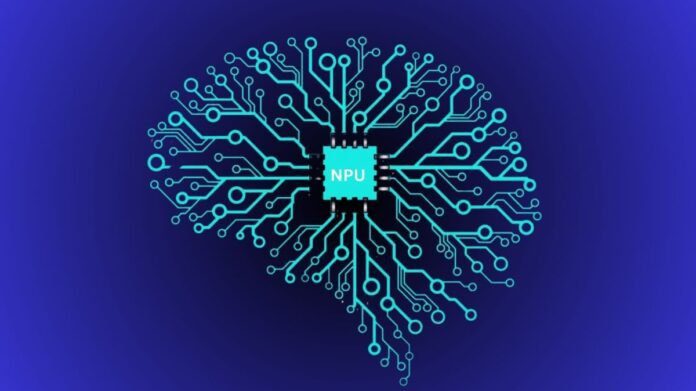What is a Neural Processing Unit?
A Neural Processing Unit NPU mimics how the brain processes information. They excel at deep learning, machine learning, and AI neural networks.
NPUs are designed to speed up AI operations and workloads, such as computing neural network layers made up of scalar, vector, and tensor arithmetic, in contrast to general-purpose central processing units (CPUs) or graphics processing units (GPUs).
Often utilized in heterogeneous computing designs that integrate various processors (such as CPUs and GPUs), NPUs are often referred to as AI chips or AI accelerators. The majority of consumer applications, including laptops, smartphones, and mobile devices, integrate the NPU with other coprocessors on a single semiconductor microchip known as a system-on-chip (SoC). However, large data centers can use standalone NPUs connected straight to a system’s motherboard.
Manufacturers are able to provide on-device generative AI programs that can execute AI workloads, AI applications, and machine learning algorithms in real-time with comparatively low power consumption and high throughput by adding a dedicated NPU.
Key features of NPUs
Deep learning algorithms, speech recognition, natural language processing, photo and video processing, and object detection are just a few of the activities that Neural Processing Unit NPU excel at and that call for low-latency parallel computing.
The following are some of the main characteristics of NPUs:
Parallel processing: To solve problems while multitasking, NPUs can decompose more complex issues into smaller ones. As a result, the processor can execute several neural network operations at once.
Low precision arithmetic: To cut down on computing complexity and boost energy economy, NPUs frequently offer 8-bit (or less) operations.
High-bandwidth memory: To effectively complete AI processing tasks demanding big datasets, several NPUs have high-bandwidth memory on-chip.
Hardware acceleration: Systolic array topologies and enhanced tensor processing are two examples of the hardware acceleration approaches that have been incorporated as a result of advancements in NPU design.
How NPUs work
Neural Processing Unit NPU, which are based on the neural networks of the brain, function by mimicking the actions of human neurons and synapses at the circuit layer. This makes it possible to execute deep learning instruction sets, where a single command finishes processing a group of virtual neurons.
NPUs, in contrast to conventional processors, are not designed for exact calculations. Rather, NPUs are designed to solve problems and can get better over time by learning from various inputs and data kinds. AI systems with NPUs can produce personalized solutions more quickly and with less manual programming by utilizing machine learning.
One notable aspect of Neural Processing Unit NPU is their improved parallel processing capabilities, which allow them to speed up AI processes by relieving high-capacity cores of the burden of handling many jobs. Specific modules for decompression, activation functions, 2D data operations, and multiplication and addition are all included in an NPU. Calculating matrix multiplication and addition, convolution, dot product, and other operations pertinent to the processing of neural network applications are carried out by the dedicated multiplication and addition module.
An Neural Processing Unit NPU may be able to do a comparable function with just one instruction, whereas conventional processors need thousands to accomplish this kind of neuron processing. Synaptic weights, a fluid computational variable assigned to network nodes that signals the probability of a “correct” or “desired” output that can modify or “learn” over time, are another way that an NPU will merge computation and storage for increased operational efficiency.
Testing has revealed that some NPUs can outperform a comparable GPU by more than 100 times while using the same amount of power, even though NPU research is still ongoing.
Key advantages of NPUs
Traditional CPUs and GPUs are not intended to be replaced by Neural Processing Unit NPU. Nonetheless, an NPU’s architecture enhances both CPUs’ designs to offer unparalleled and more effective parallelism and machine learning. When paired with CPUs and GPUs, NPUs provide a number of significant benefits over conventional systems, including the ability to enhance general operations albeit they are most appropriate for specific general activities.
Among the main benefits are the following:
Parallel processing
As previously indicated, Neural Processing Unit NPU are able to decompose more complex issues into smaller ones in order to solve them while multitasking. The secret is that, even while GPUs are also very good at parallel processing, an NPU’s special design can outperform a comparable GPU while using less energy and taking up less space.
Enhanced efficiency
NPUs can carry out comparable parallel processing with significantly higher power efficiency than GPUs, which are frequently utilized for high-performance computing and artificial intelligence activities. NPUs provide a useful way to lower crucial power usage as AI and other high-performance computing grow more prevalent and energy-demanding.
Multimedia data processing in real time
Neural Processing Unit NPU are made to process and react more effectively to a greater variety of data inputs, such as speech, video, and graphics. When response time is crucial, augmented applications such as wearables, robotics, and Internet of Things (IoT) devices with NPUs can offer real-time feedback, lowering operational friction and offering crucial feedback and solutions.
Neural Processing Unit Price
Smartphone NPUs: Usually costing between $800 and $1,200 for high-end variants, these processors are built into smartphones.
Edge AI NPUs: Google Edge TPU and other standalone NPUs cost $50–$500.
Data Center NPUs: The NVIDIA H100 costs $5,000–$30,000.


